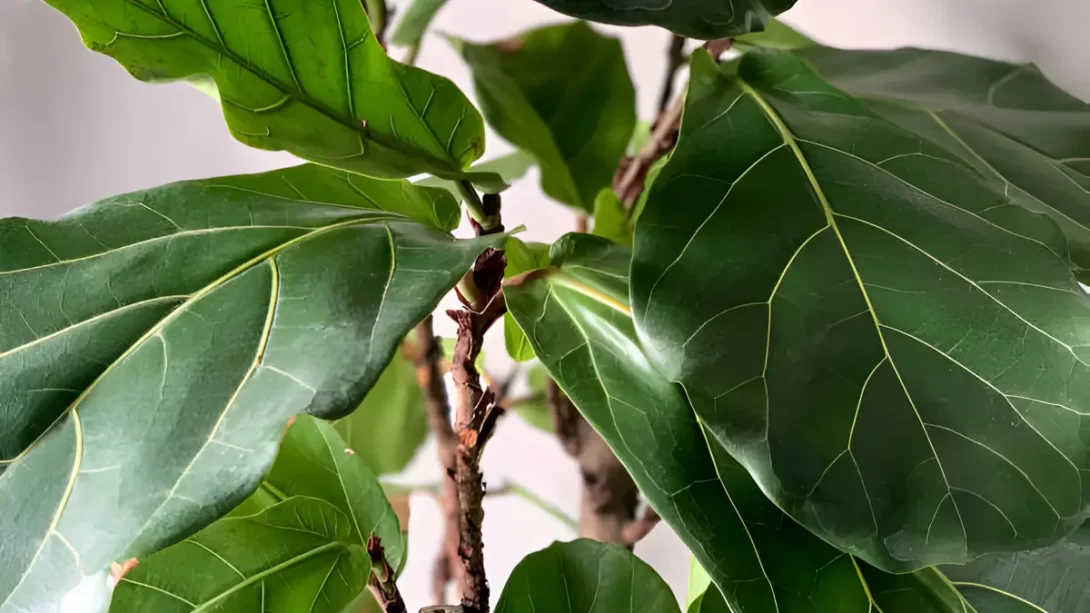The Fiddle Leaf Fig, known scientifically as Ficus lyrata, has become a widely beloved houseplant, gracing homes with its distinctive, large, violin-shaped leaves. Its lush foliage and striking appearance make it a favorite among plant enthusiasts. However, to maintain its beauty and health, repotting is a necessary task. This process not only provides fresh nutrients but also encourages continued growth and prevents root binding. Knowing when and how to repot your Fiddle Leaf Fig is key to its longevity and vigor.
When to Repot Your Fiddle Leaf Fig
Repotting your Fiddle Leaf Fig should ideally be done during the growing season, typically in the spring. This timing allows the plant to recover and grow more effectively in the warmer months. It’s crucial to watch for signs that your plant is becoming root-bound. These signs include roots peeking out of the drainage holes, slowed growth, or the soil drying out more quickly than usual. However, it’s important to avoid repotting too frequently, as this can stress the plant. A general guideline is to repot every 2-3 years, or when these signs become evident.
Choosing the Right Pot
Selecting the correct pot is vital for the health of your Fiddle Leaf Fig. The new pot should be 2-3 inches larger in diameter than the current one, providing ample room for root growth. While choosing the material—whether it be terracotta, ceramic, or plastic—ensure it has adequate drainage holes to prevent waterlogging, which can lead to root rot. Additionally, consider the pot’s appearance and how it complements your Fiddle Leaf Fig’s aesthetic, as this plant is often a focal point in home décor.
Selecting the Appropriate Soil
The right soil mix is crucial for the well-being of your Fiddle Leaf Fig. It prefers a fast-draining, high-quality potting soil. This type of soil ensures adequate drainage and aeration, key factors in preventing root rot and other common issues. If you find the soil retaining too much moisture, consider mixing in perlite or sand to increase drainage. This balance provides the roots with the ideal environment for growth and nutrient absorption.
Step-by-Step Guide to Repotting
Before diving into the repotting process, gather your materials: the new pot, appropriate soil, a watering can, pruning shears, and gloves. Here’s how to proceed:
- Pre-Watering: Water your Fiddle Leaf Fig one or two days before repotting. This makes the soil more pliable and reduces stress on the plant during the process.
- Removing the Plant: Carefully tip the pot on its side and gently ease the plant out. If it’s stubborn, tap the pot’s sides or bottom to loosen the soil.
- Root Inspection and Trimming: Once out, inspect the root ball. Trim away any excessively long, circling, or damaged roots to encourage new growth. Be cautious not to over-trim, as this can shock the plant.
- Placing in the New Pot: Add a layer of fresh soil to the bottom of the new pot. Position your plant in the center, ensuring it sits at the same depth as in its previous pot. Fill around the roots with more soil, gently tapping to remove air pockets.
- Stabilizing the Plant: Once repotted, press the soil down lightly around the base to stabilize the plant. Ensure it’s standing straight and secure.
Aftercare Tips
After repotting, your Fiddle Leaf Fig will need some time to adjust. Here are some aftercare tips to help it thrive:
- Watering: Water the plant thoroughly after repotting, then allow the soil to dry out slightly more than usual between waterings. This helps the roots grow into the new soil.
- Positioning: Keep your repotted Fiddle Leaf Fig in a bright, indirect light location. Avoid direct sunlight immediately after repotting to reduce stress on the plant.
- Observation: Monitor your plant closely for the first few weeks. New growth is a good sign, but don’t be alarmed if there’s some initial leaf drop, as this is a common stress response.
Troubleshooting Common Issues
Even with careful repotting, you might encounter some issues. Here’s how to troubleshoot:
- Leaf Drop: If your plant drops a few leaves shortly after repotting, don’t panic. This is often a stress response. Ensure you’re providing proper care, and it should recover.
- Root Rot: If you notice a foul smell or overly mushy roots during repotting, this could be root rot. Trim away the affected parts and ensure good drainage in your new pot.
- Stunted Growth: If growth seems slow, check if the pot size is appropriate and if the plant is getting enough light and nutrients. Adjust care as needed.
By addressing these issues promptly and adjusting your care routine, your Fiddle Leaf Fig can bounce back from repotting stress and continue to grow healthily.
Fertilizing After Repotting
Fertilization plays a crucial role in the post-repotting care of your Fiddle Leaf Fig. Wait about 4-6 weeks after repotting before introducing fertilizer, allowing your plant to settle in its new environment. Use a balanced, water-soluble fertilizer, diluted to half the recommended strength. Fertilize once a month during the growing season (spring and summer) and reduce or stop in the fall and winter when growth naturally slows.
Long-Term Care and Maintenance
To ensure the ongoing health of your Fiddle Leaf Fig, consistent care is key. Regularly check the soil moisture, maintaining a balance where the soil is moist but not waterlogged. In terms of light, Fiddle Leaf Figs favor bright, indirect sunlight. Rotate the plant occasionally to ensure even growth. Pruning is also beneficial, not only for shaping the plant but also for encouraging fuller growth. Remove any dead or yellowing leaves to keep your plant looking and feeling its best.
Recognizing a Thriving Plant
A successfully repotted Fiddle Leaf Fig will show signs of new growth within a few weeks to months, depending on the season. Look for new leaves and increased stability in the pot as indicators of a healthy root system. Remember, a bit of leaf loss right after repotting is normal, but vibrant new growth is a clear sign of a thriving plant.
Conclusion
Repotting your Fiddle Leaf Fig is an essential part of its care routine. By following these steps, you provide your plant with the space and resources it needs to flourish. Remember, each Fiddle Leaf Fig is unique, so observe your plant closely and adjust care as needed. With patience and regular attention, your Fiddle Leaf Fig will continue to grow and bring natural beauty to your home for years to come.




